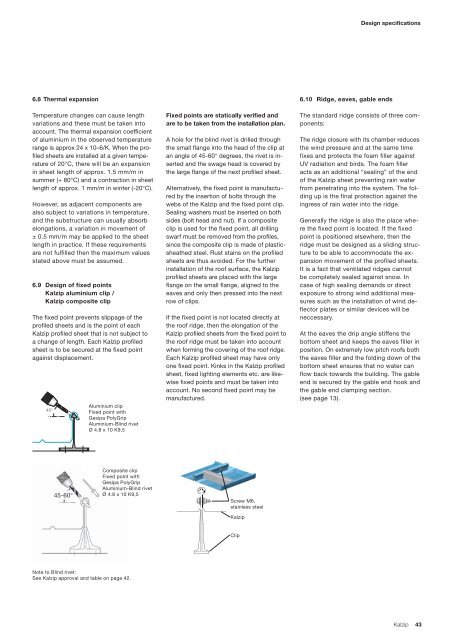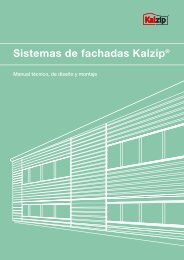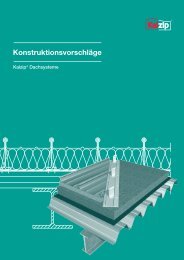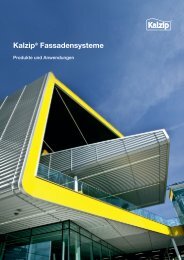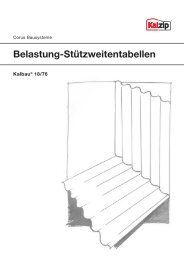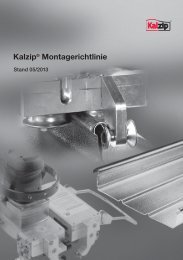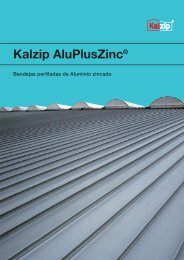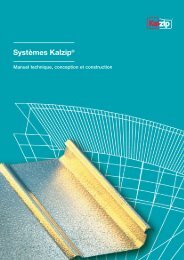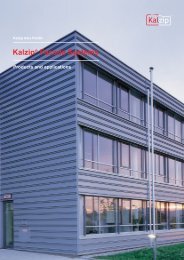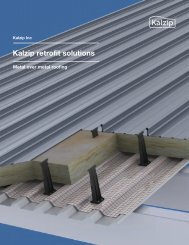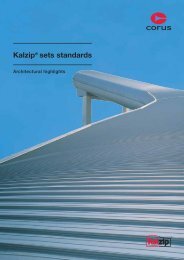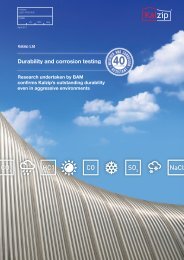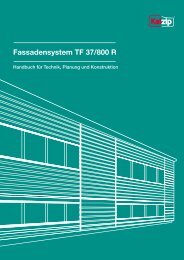Kalzip® Systems
Kalzip® Systems
Kalzip® Systems
You also want an ePaper? Increase the reach of your titles
YUMPU automatically turns print PDFs into web optimized ePapers that Google loves.
Design specifications<br />
6.8 Thermal expansion<br />
Temperature changes can cause length<br />
variations and these must be taken into<br />
account. The thermal expansion coefficient<br />
of aluminium in the observed temperature<br />
range is approx 24 x 10–6/K. When the profiled<br />
sheets are installed at a given temperature<br />
of 20°C, there will be an expansion<br />
in sheet length of approx. 1.5 mm/m in<br />
summer (+ 80°C) and a contraction in sheet<br />
length of approx. 1 mm/m in winter (-20°C).<br />
However, as adjacent components are<br />
also subject to variations in temperature,<br />
and the substructure can usually absorb<br />
elongations, a variation in movement of<br />
± 0.5 mm/m may be applied to the sheet<br />
length in practice. If these requirements<br />
are not fulfilled then the maximum values<br />
stated above must be assumed.<br />
6.9 Design of fixed points<br />
Kalzip aluminium clip /<br />
Kalzip composite clip<br />
The fixed point prevents slippage of the<br />
profiled sheets and is the point of each<br />
Kalzip profiled sheet that is not subject to<br />
a change of length. Each Kalzip profiled<br />
sheet is to be secured at the fixed point<br />
against displacement.<br />
Aluminium clip<br />
Fixed point with<br />
Gesipa PolyGrip<br />
Aluminium-Blind rivet<br />
Ø 4.8 x 10 K9,5<br />
Fixed points are statically verified and<br />
are to be taken from the installation plan.<br />
A hole for the blind rivet is drilled through<br />
the small flange into the head of the clip at<br />
an angle of 45-60° degrees, the rivet is inserted<br />
and the swage head is covered by<br />
the large flange of the next profiled sheet.<br />
Alternatively, the fixed point is manufactured<br />
by the insertion of bolts through the<br />
webs of the Kalzip and the fixed point clip.<br />
Sealing washers must be inserted on both<br />
sides (bolt head and nut). If a composite<br />
clip is used for the fixed point, all drilling<br />
swarf must be removed from the profiles,<br />
since the composite clip is made of plasticsheathed<br />
steel. Rust stains on the profiled<br />
sheets are thus avoided. For the further<br />
installation of the roof surface, the Kalzip<br />
profiled sheets are placed with the large<br />
flange on the small flange, aligned to the<br />
eaves and only then pressed into the next<br />
row of clips.<br />
If the fixed point is not located directly at<br />
the roof ridge, then the elongation of the<br />
Kalzip profiled sheets from the fixed point to<br />
the roof ridge must be taken into account<br />
when forming the covering of the roof ridge.<br />
Each Kalzip profiled sheet may have only<br />
one fixed point. Kinks in the Kalzip profiled<br />
sheet, fixed lighting elements etc. are likewise<br />
fixed points and must be taken into<br />
account. No second fixed point may be<br />
manufactured.<br />
6.10 Ridge, eaves, gable ends<br />
The standard ridge consists of three components:<br />
The ridge closure with its chamber reduces<br />
the wind pressure and at the same time<br />
fixes and protects the foam filler against<br />
UV radiation and birds. The foam filler<br />
acts as an additional “sealing” of the end<br />
of the Kalzip sheet preventing rain water<br />
from pene trating into the system. The folding<br />
up is the final protection against the<br />
ingress of rain water into the ridge.<br />
Generally the ridge is also the place where<br />
the fixed point is located. If the fixed<br />
point is positioned elsewhere, then the<br />
ridge must be designed as a sliding structure<br />
to be able to accom modate the expansion<br />
movement of the profiled sheets.<br />
It is a fact that ventilated ridges cannot<br />
be completely sealed against snow. In<br />
case of high sealing demands or direct<br />
exposure to strong wind additional measures<br />
such as the installation of wind deflector<br />
plates or similar devices will be<br />
neccessary.<br />
At the eaves the drip angle stiffens the<br />
bottom sheet and keeps the eaves filler in<br />
position. On extremely low pitch roofs both<br />
the eaves filler and the folding down of the<br />
bottom sheet ensures that no water can<br />
flow back towards the building. The gable<br />
end is secured by the gable end hook and<br />
the gable end clamping section.<br />
(see page 13).<br />
45-60°<br />
Composite clip<br />
Fixed point with<br />
Gesipa PolyGrip<br />
Aluminium-Blind rivet<br />
Ø 4.8 x 10 K9,5<br />
Screw M6,<br />
stainless steel<br />
Kalzip<br />
Clip<br />
Note to Blind rivet:<br />
See Kalzip approval and table on page 42.<br />
Kalzip 43


